Wikipedia is not only one of the most reputable online encyclopedias, it can also be one of the most reputable link sources in terms of SEO. Caution is warranted though, because a very interesting paradox is at play here: the less Wikipedia is being used for SEO, the more credible and valuable it is as a link source. Furthermore, the more credible and valuable it is, the more appealing it becomes. But be aware: if you are now rushing to the crowd-sourced encyclopedia to insert your links in every article you can get your hands on, you will be hurting both Wikipedia and yourself.
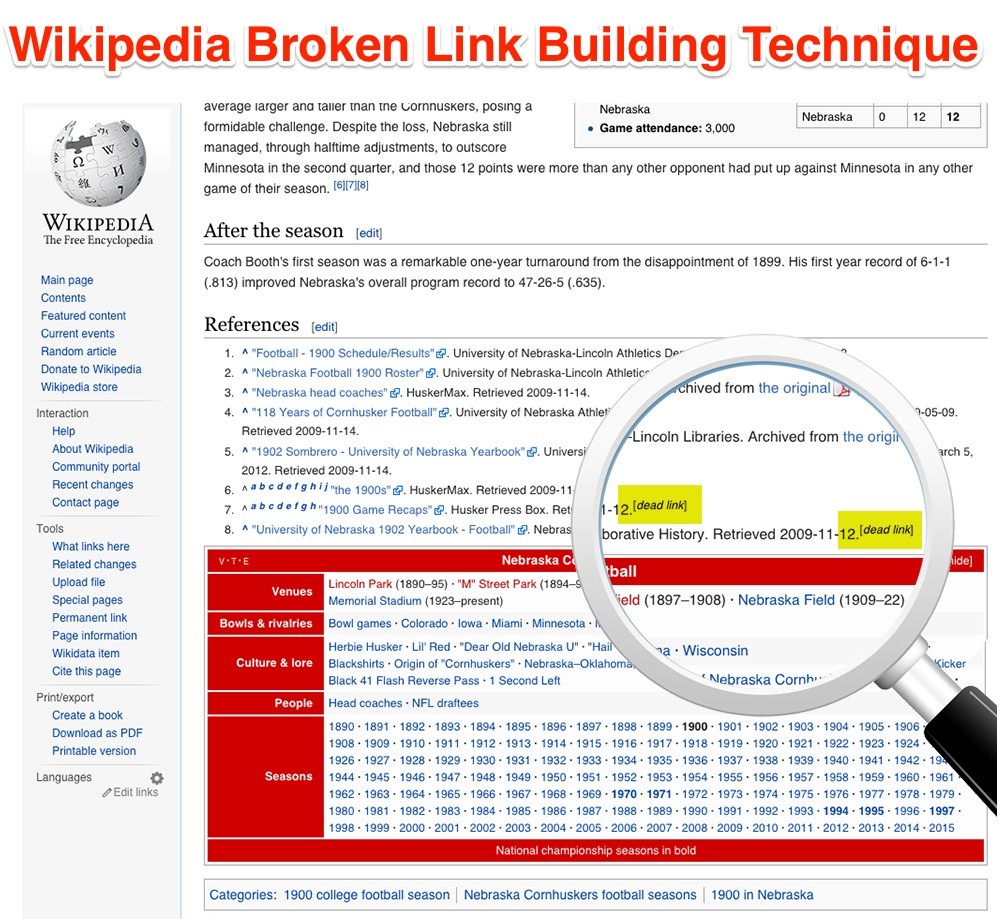
Why Can Wikipedia Links Be Great and Yet Dangerous?
In order to be effective in your Wikipedia Link Building campaign, you need to understand the context in which you will be working. First and most important, Wikipedia is nonprofit.
Not only that Wikipedia’s goal is not to make money but they’re also trying to actively discourage others to make money on their back.
That’s why, for instance, it does not give out link juice (all of their links are nofollow). So any “in-your-face” commercial/marketing endeavor is bound to fail. Secondly, Wikipedia is a crowd-sourcing effort, swarming with editors who are all extremely dedicated to keeping the encyclopedia as accurate as unbiased as possible. Test their patience and you might find yourself on a spam list. So any transparent SEO effort is bound to fail fast. But because the reward can be so tempting, you might still want to try your luck. So how do you do it? Jon Cooper at Point Blank SEO offers some pretty good advice when he suggests that the number one rule should be to focus on adding content, not links. It might even be that in the beginning you will only add content (the links come later, maybe even much later). And when you finally do add links, you don’t add them in the article and you don’t add just links to one particular site (your site).
The Wikipedia Link Rot Advantage
You truly have to work in the best interest of the article and not simply pursue your self-promotion.
While this approach is sound, it is not the only one. There is also a more subtle approach to link building on Wikipedia: broken link building. This, in essence, means looking up dead links in Wikipedia articles and persuading page editors to substitute those dead links with other active, relevant links. Sometimes, it might just happen that one of the substitute links be yours. But remember: it still has to be relevant to the article and relatively unbiased. This approach is perhaps less intrusive than straight-up adding new links, since it uses a “space” which already existed. The disadvantage of Wikipedia is that by being so vast it is quite difficult to keep track of changes, even with an army of editors. But when it comes to dead links, that’s your opportunity. Because you don’t even have to waste too much time researching, since Wikipedia even has a page for articles with dead links . You don’t have to do a lot of manual work that would probably be quite discouraging and fruitless. Moreover, you can look exactly for the articles for which you might be able to provide relevant content and links.
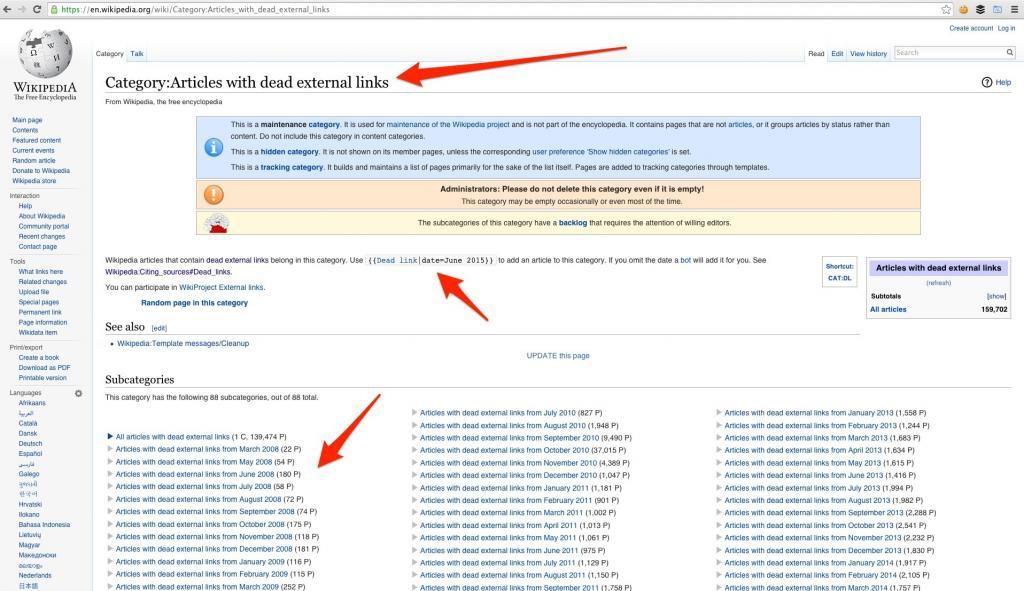
Wikipedia Broken Link Building Process
Long story short, let’s look a bit closer at how the process works and see the exact steps you need to follow in order to be successful in your quest .
1. Identify Wikipedia Pages in Your Niche with Broken Links
The first step will be to identify the Wikipedia pages which are relevant to you and which have dead links. And what is the easiest way to find things? Just google it; not randomly but using a query that will help you spot directly the dead links in Wikipedia. If you search for dead links for a particular niche (let’s say cosmetic surgery) within Wikipedia, your search might look something like this:
site:wikipedia.org “cosmetic surgery” intext:”dead link”
And the magic is done!
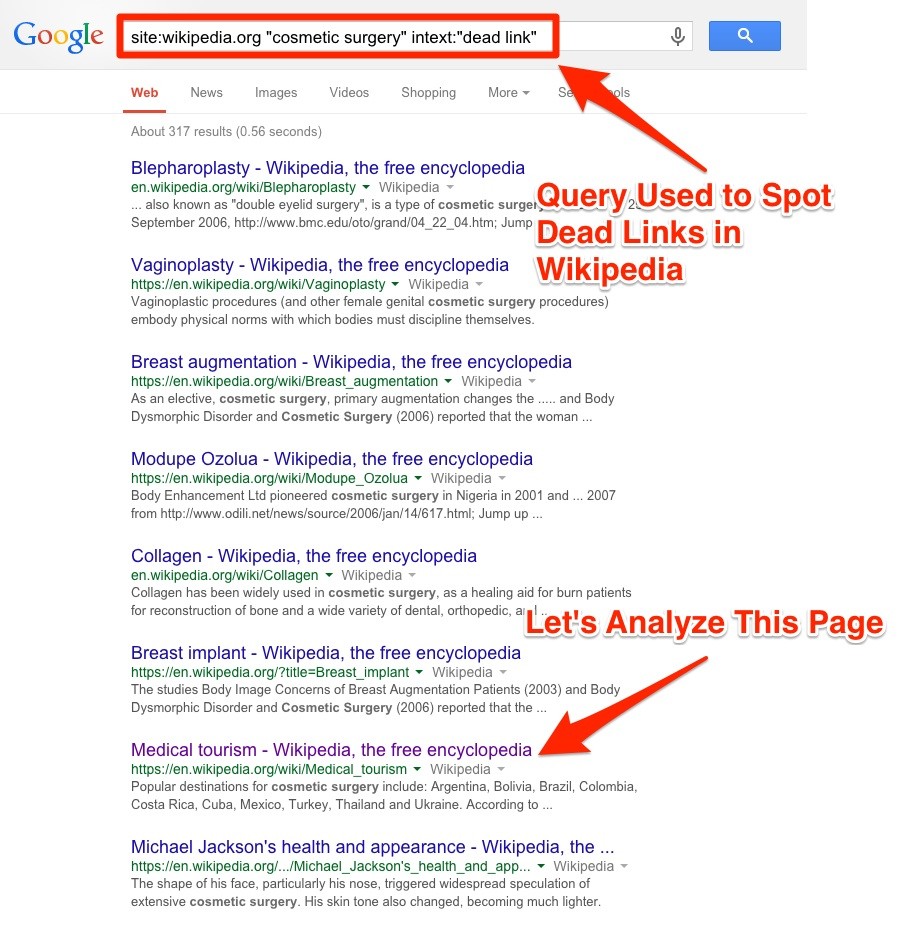
We already mentioned the “Articles with dead external links” page on Wikipedia. You can also go into specific pages and look at the link references section at the end. Let’s take a closer look at the “Medical Tourism” page suggested by Google to contain dead links. As we access this page (and others of this kind), you will notice that broken or dead links are marked with a “dead link” label at the end. If you do try to click that link, it will lead you to a 404 page. Or, if you stumble upon an article with a particularly large reference list, simply Ctrl+F your way out of it by searching for “dead link” on that page.
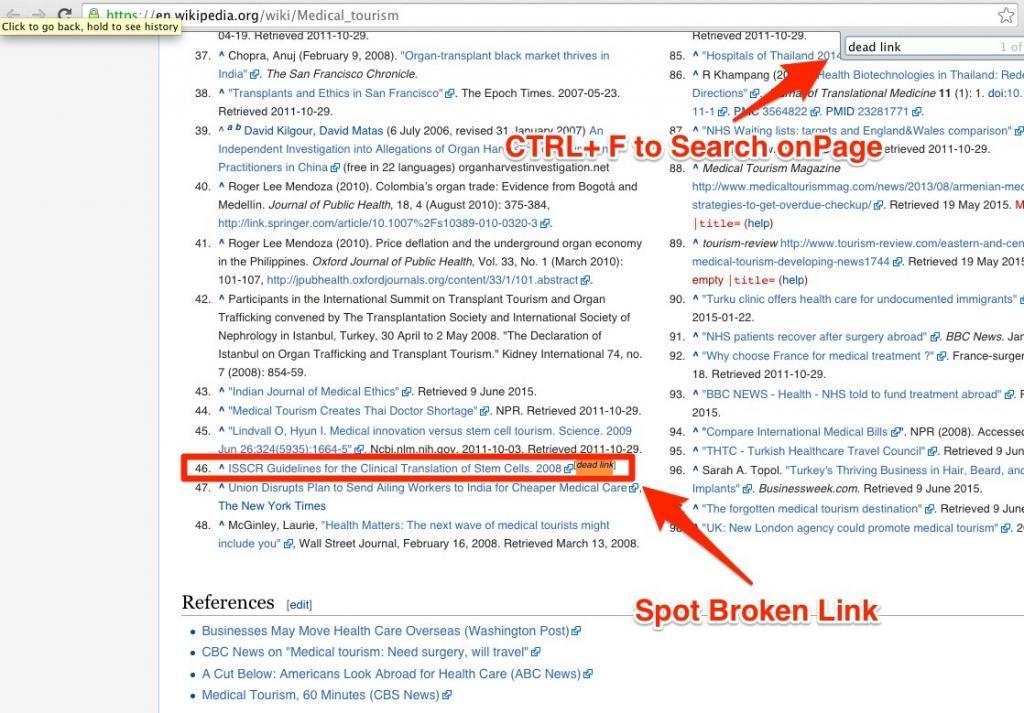

2. Identify Broken Links with Multiple Referring Domains
However, just because this strategy is particularly useful for Wikipedia, it doesn’t mean that’s all it’s good for. If possible, you will want to leverage this as much as possible. This means you can extend your search for broken links to much more than Wikipedia.
You should actually look for broken Wikipedia links that have other links pointing to it. This way you can effectively scale your broken link building.
For instance, the page http://www.isscr.org/clinical_trans/index.cfm is broken, yet has a bunch of referring domains pointing to it. Using cognitiveSEO’s Site Explorer we see 43 potential referring domains that we can take advantage of, and we found this out with just a simple query.
All those domains have now become link-building opportunities.
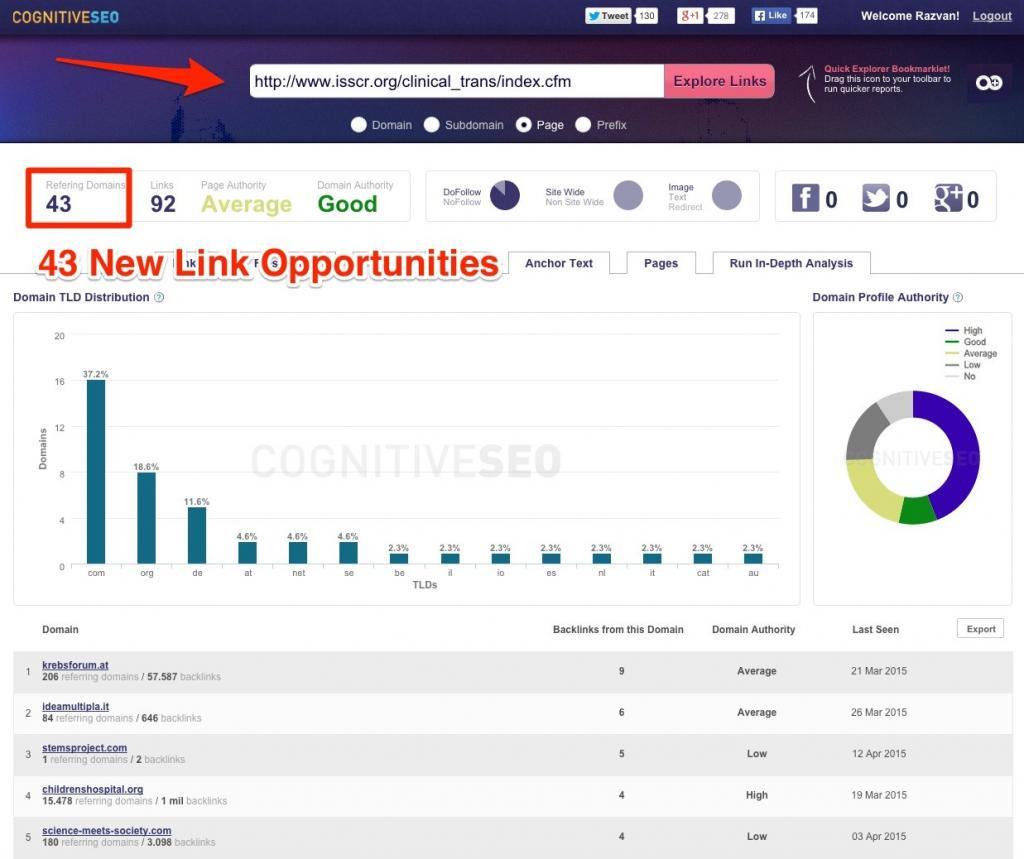
3. Extract the Original Content of the Page Using the Wayback Machine
Next we need to recover the content of the original (now broken) page with the help of the Wayback Machine, which is an Internet archive dating all the way back to 1996 . Because you will be able to see the page as it looked when it still worked (and it must’ve been working at some point, right?) you will be able to access its content. Now you don’t just have alternative content. You have the original content plus new content you will want to add to make your page even better. Here is the search we made and below you can see the screenshot with the exact content that was posted on our link building opportunity from the cosmetic surgery niche,
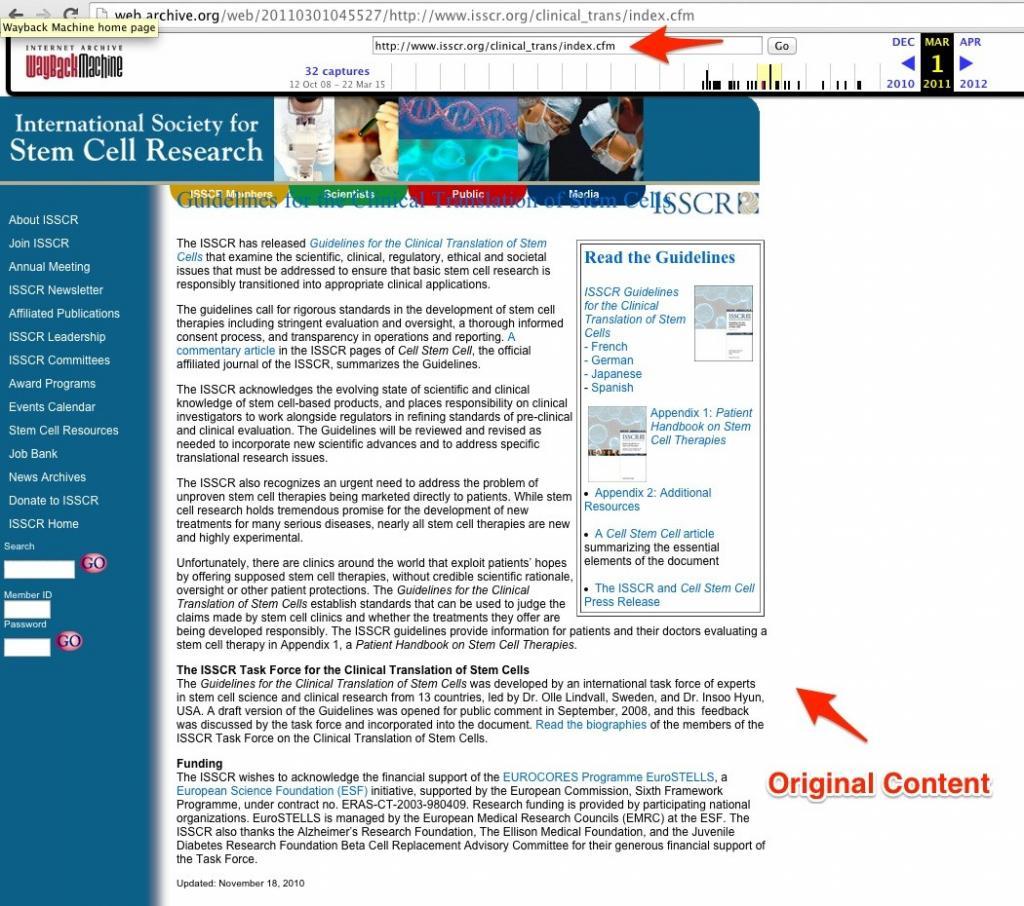
4. Recreate the 404 Page on Your Site with Even Better Content
What does it mean to recreate the page?
First and foremost, pick broken links in your niche.
It’s no use to recreating a page on mental disorder classification if you’re dabbling in fashion. The pages you recreate need to fit in nicely with the rest of your content. Once that condition is met, just try to focus as much as possible not only on straight lifting the old content, but on improving it. Look in all the possible places: has any new information about the subject surfaced? It’s best to add it or even replace whatever information is now known no longer accurate. Was the structure of the original page hard to follow or simply not attractive enough?
Play around with it until you’re sure the content on the page will be easy to read but also engrossing and useful.
Last but not least, this is still SEO, so the words you use still matter a lot.
Go to blogs and discussion forums and see what they’re interested in when they’re talking about what you’re writing.
Check out social networking sites and make note of the hashtags and comments of shared content. As much as possible, try to incorporate all of this into your newly-created content.
5. Getting the Golden Link from Wikipedia
Now comes the trickiest part. How do you substitute your new, live content for the old, dead one? It’s actually not that tricky, but it might involve a bit of luck.
Most likely, it boils down to how well-intended you present yourself and how much good will can be assumed on your part.
There is no complex strategy or sneaky tactic: you simply have to contact the Wikipedia page or website editor or owner and let them know that one of their references leads to a dead page, but you happen to be able to provide an alternative link with even better content. At least that’s what Doug Cunnington suggests over at Matthew Woodward. Brian Dean goes into a bit more detail in his Backlinko article and offers a more polished approach, suggesting how to create the afore-mentioned good-will image as well. He suggests, among others, offering reasons when contacting people about updating links (not just saying “do this”, but “do this because…”), doing research on keywords before choosing the best ones to attach to your content (and even creating your own keywords), as well as mimicking Wikipedia’s own style in your content so as to maximize the chance of updating your link in one of their articles.
6. Get Links from All the Other Referring Domains Too
If this doesn’t work for Wikipedia (and there’s still a chance it might not, despite best practices), you can still try to apply the strategy for other websites. If you decide to do this, writing outreach e-mails is still your best choice. But in order for it to work, it really needs to be unique. You have to be unique and try to sound as unSEO-ish as possible. You know the SEO language: you’ve seen it in comments on blog posts or in posts in forum threads. Would you react positively to that kind of message? Probably not, or at the very least, you would be at least suspicious. So don’t send outreach emails if you don’t actually mean them. Just as your content needs to be focused on readers and not on your website (or whatever you’re selling), your outreach needs to be focused on the person at the other end, not on you making your pitch.Get rid of empty language and tailor your message to your receiver.
Taking advantage of the broken link opportunities that lay out before you can be pretty rewarding, but only if you put time and effort into it.
Yet, finding all the contact info in order to outreach to hundreds of webmasters can be tiresome and resource consuming. For your wellbeing, you can automate the whole process using tools for contact extraction such as Rapportive , BulkWhoisFinder or Atomic Email Hunter.
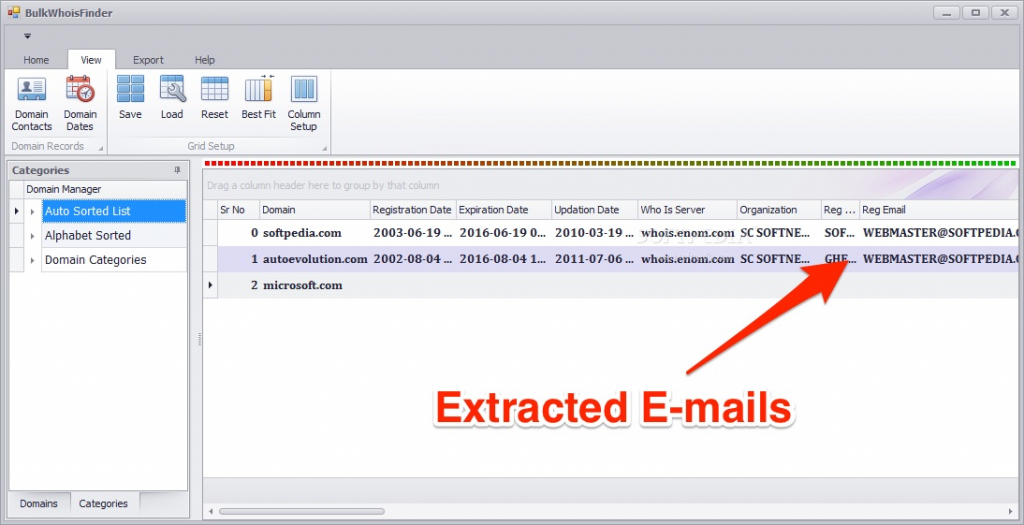
The screenshot above is the BulkWhoisFinder in action. You simply import the list of domains/links and the tool automatically extracts the contact information from their website or other information sources. All the outreach tools mentioned above display the emails extracted for each link that you’ve imported, together with keyword and country of the owner, info that would have taken you a lot of time to find manually.
Conclusion
All encyclopedic content on Wikipedia must be written from a neutral point of view (NPOV), which means representing fairly, proportionately, and, as far as possible, without bias, all of the significant views that have been published by reliable sources on a topic. As NPOV is a fundamental principle of Wikipedia, you need to keep that in mind when trying to gain links from the well known encyclopedia. It’s true that Wikipedia presents itself as “the encyclopedia that anyone can edit”. Well, that is almost true. Anyone who plays along with Wiki’s rules and doesn’t lead to a conflict of interest. Ranking for almost half of all searches, it may only be natural for any webmaster to dream of a Wikipedia link pointing to his site. And like almost any other good linking opportunity in the SEO world, this method has been highly used and abused. This made Wikipedia implement a ”nofollow” policy on all outbound links, which means links from Wikipedia do not pass PageRank or anchor text. And although the controversies around nofollow links are still on fire, just because Wikipedia links are nofollow, doesn’t mean they aren’t valuable. Getting links from the largest online encyclopedia might be a real hassle. Hopefully, this article has managed to draw some clear directions in this whole process and make things if not easier, at least more explicit and straightforward. Wikipedia is indeed an amazing resource that you can use to boost your own site. Yet, always keep in mind that it isn’t a shortcut to building your site’s digital marketing approach nor a replacement for content strategy. It’s definitely not a place to spam but also not a place to ignore.

 Site Explorer
Site Explorer Keyword tool
Keyword tool Google Algorithm Changes
Google Algorithm Changes

This methods is great for quality link building, yet relies on getting dead links in wikipedia within your niche and with people linking to the dead source. Tried it a few times, volumes of potential backlinks were often equal to zero :\
But as usual, link building is based on regular work using multiple techniques to get a few backlinks from times to times !
it is really up to your niche. but the great advantage here is that you can benchmark this technique in minutes as you see the broken links very easy. once you do that and if there is volume you can start and filter out the most worthy candidates by looking of high referring domain links. once identified it is just another broken link building and it can come up with success ratios of 10%-50%. It is up to your creativity on what kind of page you recreate and what kind of outreach you do.
Very well done. This is such a smart idea. Just looking for dead links is too consuming, but finding them first on wikipedia and going from there: brilliant!
You can use WIKIGRABBER to filter out. It will save your time. 🙂
Wow!Its all that I could muster. Simply brilliant, Wikipedia is a gold mine waiting to be tapped by all the existing and aspiring SEO consultants. Many thanks! Really enjoyed!
jeje, very nice tips! Very many thanks for the great instructions on how to do it.
What a very smart tip, I am new to blogging and in a process of learning but whether it is SEO or anything else, it’s a brilliant idea. People knows that Wikipedia is one of the most famous website in the internet that attracts millions of users every day. Being linked with them would be great!
Awesome article. Really very very helpful!
Just wanted to add, that there are a lot of broken links in Wiki that are not marked as dead links (at least yet).
Great post Razvan.
Just fyi, I mentioned this post in a roundup of link building resources! Awesome work!
cool. tks ALex for letting me know 😉
Its an amazing article. i tried one for my directory website and worked greatly improved my authority. now ranked in the first page.
Very safe and effective way to build links. If a webpage is good enough to be mentioned in wikipedia, it is natural that there would be many more websites linking to the page. More than the wiki link, the links which you could get from all the websites that are linking to the broken link can really help your rankings.
Wow!Its all that I could summon. Just splendid This is such a keen thought. Simply searching for dead links is excessively expending, however discovering them first on wikipedia and going from that point: splendid!
Really amazing article. This was what I was looking for. Matthew Woodard also wrote something similar, but not as detailed and precise as you did.Did not realise Wiki is such a big gold mine for backlinks.
Cheers, keep up the good work, bookmarked this straight away!!!
This is absolutely an amazing technique. Thanks for sharing with us.
Really another great post. I was looking for a way out of the world. Your idea is something i would definitely work upon. Hope to get better keyword rankings in near future. But the problem is, it shows just few results when searched as you suggested. I think we have go with some variables of our niche.
Hello, I discovered permanent dead link at wikipedia. Can I use your trick for permanent dead link?
Thank you for the free piece of advice. I was looking to buy a software for over $100 just to show me the dead links, but your query save the day!
I will definitely try cognitiveSEO’s Site Explorer.
very helpful article. I use this article to rank my website in the top on Nepal.
You know, I love this technique but I have to be honest…most website owners don’t respond and editors would rather edit the article Link out than changing it. They are getting wise to the ways!
Most of the seo people not using this Golden link building strategy because of #Lack Of Knowledge.
This Guide is really help them & me to Start 404 Link Building Strategy.
Thank You So much!
Very well Work. This is a smart idea. Just seeing for dead links is too consuming, but finding them 1st on wikipedia and going from there, brilliant!
This is absolutely an amazing technique. Thanks for sharing with us.
This is a great tool I wonder if there is a way to automate this process somehow? thanks so much for this post.